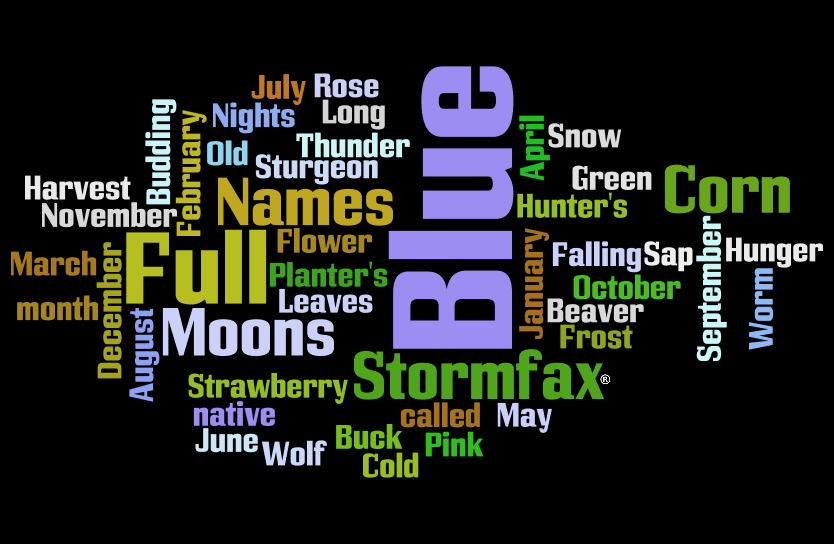


| January: | Wolf Moon, Old Moon |
| February: | Snow Moon, Hunger Moon |
| March: | Worm Moon, Sap Moon |
| April: | Pink Moon, Planter's Moon |
| May: | Flower Moon, Budding Moon |
| June: | Strawberry, Rose Moon |
| July: | Buck Moon, Thunder Moon |
| August: | Sturgeon Moon, Green Corn Moon |
| September: |
Harvest Moon (see below for
explanation), Corn Moon |
| October: |
Hunter's Moon, Moon of Falling Leaves |
| November: |
Beaver Moon, Frost Moon |
| December: |
Cold Moon, Long Nights Moon |
|
|
| Harvest moon: |
The Full Moon nearest the Northern Hemisephere's autumnal equinox (September 22 or 23).
The Harvest Moon comes in September, but in some years it occurs in October.
At the peak of harvest, farmers can work late into the night by the light of this Moon.
|

Full moons that occurred too early (in August) were sometimes called the Green Corn Moon
to distinguish them from the later moon when the plants were ready for harvesting.

| Month | Moon name | Meaning |
| January | Wolf | Hungry wolf packs howl at night |
| February | Snow | Heaviest snowfalls in the middle of Winter |
| March | Worm | At the start of Spring, the earthworms began to appear |
| April | Pink | An early Spring flower called "Mountain Pinks" start to bloom |
| May | Flower | Many types of flowers bloom in May |
| June | Strawberry | Strawberries are ready to be picked |
| July | Buck | New antlers on buck deer begin to appear |
| August | Sturgeon | Sturgeon, a fish found in the Great Lakes, are easily caught at this time of year |
| September | Harvest | Farmers can continue harvesting until after sunset by the light of the Full Moon |
| October | Hunter's | Hunters tracked and killed prey by moonlight, gathering food for the coming Winter |
| November | Beaver | Beaver traps are set to make sure of a supply of warm Winter fur |
| December | Cold | The cold of Winter tightens its grip as the nights are longest |





 Please read our Legal Notice and our Privacy Statement.
Please read our Legal Notice and our Privacy Statement.